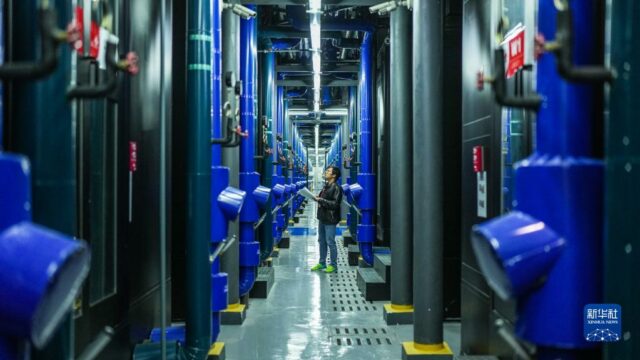
CCP Stealth War 135; Feature: Debt Woes Threaten China’s Poorest Province and Emerging Big Data Hub
By:

This Week:
* Feature: Debt Woes Threaten China’s Poorest Province and Emerging Big Data Hub
* Chinese Companies Step in to Revive East Africa Crude Oil Pipeline
* DRC President Makes State Visit to China
* Microsoft, Five Eyes Warn of PRC Cyberattacks on U.S. Critical Infrastructure
* U.S. to Assist Taiwan in Obtaining NATO’s Link 22 Secure Data Link System
Feature: Debt Woes Threaten China’s Poorest Province and Emerging Big Data Hub
By Flora Yan
Yesterday, the government-sponsored 2023 China International Big Data Industry Expo, which since its establishment in 2015 has been touted as the PRC’s flagship forum showcasing and promoting big-data developments since its initiation in 2015, officially began in Guiyang, capital of southwestern Guizhou province (China Daily, February 20; China Daily, February 22; Xinhua, May 26). This year’s theme centers around exploring the deep integration of the digital and real economies (数实相融) (Xinhua, May 26).
Guizhou is one of the poorest provinces in China but was tasked with building the first national big-data comprehensive pilot zone in 2016. As a result, the province has been seen as “the front runner” of China’s big-data industry, which has been increasingly promoted as the “mainstay” of economic development, particularly over the past three years (Xinhua, May 29, 2021; Xinhua, February 13). Beijing also appears to have placed increasing strategic importance on Guizhou, potentially in the hope that its development can play a key role in driving national economic growth.
During his early 2021 inspection tour to Guizhou, President Xi Jinping urged officials to “push for deep integration between big data and the real economy (推动大数据和实体经济深度融合) (Xinhua, February 9, 2021).”
In September 2021, the State Key Laboratory of Public Big Data, China’s first key State Key Lab (SKL) focused on big data, was approved for establishment at Guizhou University (Guizhou University, July 13, 2018; Xinhua, May 25; Guizhou University, August 27, 2019; Xinhua, May 25). In late 2022, Xi tapped his protége and former State Council Information Office director Xu Lin as Guizhou party chief (SCMP, December 9, 2022). Xu appears to have made “telling Guizhou’s story well” a priority, as he stressed this week during a meeting with representatives of state media outlets (Xinhua, May 26). On Twitter, in recent days in particular, People’s Daily, China Daily, as well as individual Chinese diplomats, have been posting a combination of short videos to promote tourism to the province (Twitter, May 19; Twitter, May 25; Twitter, May 24; Twitter, May 26). The Guizhou government also operates multiple highly active verified accounts (Twitter, undated; Twitter, undated).
Three months ago, Guizhou announced a $2.83 billion (20 billion yuan) investment in big-data projects for this year, with the goal of building 800,000 data center racks, 4 million servers and over 180,000 5G base stations by 2025 (Xinhua, February 13). Zeng Yi, President of China Electronics Corporation, described Guizhou as a “strategic base for China’s electronics industry” (Twitter, May 26).
Currently, Guizhou hosts 37 key data centers, including those of many major state-owned enterprises, including telecommunications behemoths, China Mobile, China Unicom and China Telecom (China Daily, March 11; Huanqiu, May 26). Multiple tech giants have also recently opened new data centers in Guizhou, including Apple, Huawei, Tencent and NetEase (China Daily, December 27, 2021; China Daily, February 1; Xinhua, May 25, 2021)
While the growth of Guizhou’s digital economy, which accounted for 36 percent of provincial GDP last year and was expected to reach 40 percent this year, has been the highest nationwide for seven years running (PRC State Council, January 14; Xinhua, February 13), massive debt has also continued to accrue.
Over the past two months, a government think tank and the finance bureau of Guizhou’s capital subsequently published reports, which were later removed, calling for financial assistance from the central government (WSJ, May 21). During the same period, Guizhou signed an agreement with a state-owned asset management firm (China Daily, April 28), shortly before the Politburo directed local governments to strengthen debt management and “strictly control hidden debt” increases (Nikkei Asia, May 8; WSJ, April 28).
In 2020, state media acclaimed that Guizhou had “shaken off absolute poverty” by lifting over 9 million people out of poverty (PRC State Council Information Office, February 7, 2021; Xinhua, November 24, 2020). Three years later, it remains to be seen whether the accelerated integration of digital and real economies (数实融合/数实相融) can lift Guizhou out of a looming debt crisis, whether Beijing will directly respond to the province’s urgent requests for assistance and what ramifications Guizhou’s experiences will have for governments as well as businesses in other regions across China (CCTV, May 25). Although the state’s promotion of a Guizhou as the flagship province for Big Data has generated growth, the burgeoning debt threatens to weaken the province’s ability to move to a higher level of economic development and eliminate poverty.
Flora Yan is a Templeton Fellow in the Asia Program at the Foreign Policy Research Institute.
BRIEFS
Chinese Companies Step in to Revive East Africa Crude Oil Pipeline
TIn mid-May, Ugandan Energy Minister Ruth Nankabirwa announced that Chinese investors would step in to rescue the $5 billion East Africa Crude Oil Pipeline (EACOP) project. EACOP—which has been plagued by hold-ups since it was originally proposed in 2016—risked further delays after more than 45 Western financial institutions pulled out or otherwise refused to fund the project. Investors and activists have expressed grave concerns over the pipeline’s potential social and environmental impacts, with the EU Parliament issuing an official condemnation of the project to that effect in September 2022.
Of the $5 billion project, $3 billion will be financed by loans, mostly obtained from the Export-Import Bank of China and “several other Chinese banks.” The remaining $2 billion will come from the current stakeholders. These include the French oil giant TotalEnergies (with a 62 percent stake), the Uganda National Oil Company and the Tanzania Petroleum Development Corporation (each with 15 percent), and the state-owned China National Offshore Oil Corporation (CNOOC, holding the remaining 8 percent).
Since commercially exploitable oil deposits were discovered around Lake Albert in 2006, numerous ill-fated attempts to extract and transport crude oil from the region have occurred. Previously, Uganda had planned on partnering with Kenya and South Sudan to develop the Uganda–Kenya Crude Oil Pipeline (UKCOP), which would have brought crude from the three countries to international markets. In 2016, following years of delays, Uganda decided to pursue the EACOP project with Tanzania instead.
China has more than just a passing interest in the EACOP project. Of the main two oil fields that the current pipeline would source from, one of two will be owned and operated by CNOOC. The Democratic Republic of the Congo, a major target of Chinese investment, has also expressed interest in connecting nearby oil fields along its eastern border to the EACOP. Rwanda, Burundi and South Sudan have also indicated a desire to connect to the pipeline once it is built.
With funding for the project arranged, construction is expected to begin sometime this summer with completion expected sometime in 2025. Several other state-owned Chinese companies have been contracted to participate: China Petroleum Pipeline Engineering will provide the pipe itself, while China Petroleum Engineering and Construction Engineering will build some of the ground facilities. China is also understood to be the primary future customer for Tanzanian and Ugandan oil exports, once the pipeline is finished.
DRC President Makes State Visit to China
From May 24 to May 29, Congolese President Felix Tshisekedi is conducting a state visit to China. Slated to visit Beijing, Shanghai and Shenzen, President Tshisekedi has already met with Chinese President Xi Jinping. At a joint meeting on May 26, Presidents Tshisekedi and Xi agreed to upgrade their bilateral relationship from a “win-win strategic partnership” to a “comprehensive strategic cooperative partnership.”
While the terminology of Chinese diplomatic partnerships can be somewhat byzantine, this upgrade places the Democratic Republic of the Congo on the same level as eight other countries, to include Tanzania, the Republic of the Congo, Vietnam and Belarus. The stated areas of focus for the ongoing talks include economic and social development, particularly in the areas of “energy, mining, agriculture, infrastructure, and manufacturing.” At the time of writing, no formal deals have yet been announced.
President Tshisekedi’s schedule includes visits to the headquarters of several (thus unannounced) Chinese battery, energy, mining and technology companies. In addition, President Tshisekedi has brought along his ministers of mines, hydropower, and defense, respectively, which may imply behind-the-scenes discussions in those areas with their Chinese counterparts.
Reports have also highlighted the ongoing renegotiation of the joint Congolese-Chinese major mining venture Sicomines; officials have confirmed the veracity of a document that states the DRC’s demand for an increase in their stake in the company from 32 percent to 70 percent. While the matter is assumed to be one of the purposes of President Tshisekedi’s visit, major breakthroughs are not expected to be announced until afterward.
Separately, on May 25, Chevron began the process of trying to sell their assets in the DRC, which are valued at roughly $1.5 billion. While this is likely related to declining production of crude from the offshore oil platforms—of which they have a 31 percent stake in—it nevertheless opens the door to further investment from other sources. Given that more than 75 percent of Congolese crude was exported to China in 2021, it is safe to assume that Beijing might be interested as the PRC broadens ties with the DRC in other areas.
Microsoft, Five Eyes Warn of PRC Cyberattacks on U.S. Critical Infrastructure
On Wednesday, Microsoft and the Five Eyes initiative, the alliance among the intelligence services of the U.S., Australia, Britain, New Zealand and Canada, issued an alert that state-backed operators have hacked into critical infrastructure systems in the U.S. and its allies. In particular, Microsoft noted that PRC-linked hackers have targeted the island of Guam, which is a key node in the U.S.’s Indo-Pacific security presence. The U.S. tech giant said hackers had installed “malicious code” to surveil and disrupt communication between the U.S. and Asia during a crisis. The “Volt Typhoon” hackers penetrated key infrastructure on Guam as earlier as mid-2021 Microsoft noted. This is merely the latest in a spate of Chinese Communist Party (CCP) linked cyber-attacks and cyber-espionage targeting the U.S.
U.S. to Assist Taiwan in Obtaining NATO’s Link 22 Secure Data Link System
Yesterday, Lee Shih-chiang, the head of the Taiwanese Ministry of National Defense’s Department of Strategic Planning, told lawmakers that the U.S. will help Taiwan obtain Link 22, which is a secure digital radio system. Taiwan’s Central News Agency noted that Link 22 is “able to provide beyond line-of-sight communications that interconnects air, surface, subsurface and ground-based tactical data systems. Link 22 would also be particularly valuable for Taiwan, as Lee noted, in that it would provide the Taiwanese military with a direct, more secure link with the U.S. military. Other benefits of Taiwan upgrading its data link system would include faster command and control and superior anti-jamming capabilities. Should the decision to provide the system to Taiwan occur, it would also suggest growing unity among the North Atlantic security bloc on the need to do more to preserve the status quo in the Taiwan Straits.



